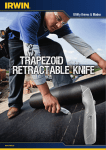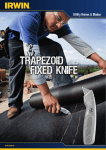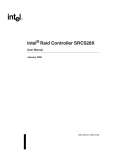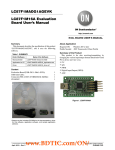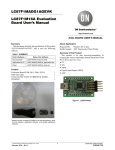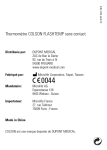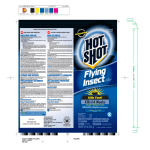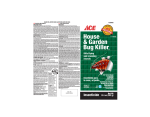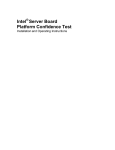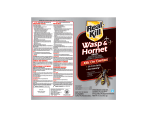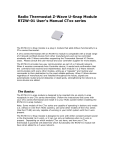Download Thermal Test Board Design
Transcript
Intel® Atom™ Processor E6xx Series Thermal Test Board User Guide September 2010 Document Number: 324473-001 INFORMATION IN THIS DOCUMENT IS PROVIDED IN CONNECTION WITH INTEL® PRODUCTS. NO LICENSE, EXPRESS OR IMPLIED, BY ESTOPPEL OR OTHERWISE, TO ANY INTELLECTUAL PROPERTY RIGHTS IS GRANTED BY THIS DOCUMENT. EXCEPT AS PROVIDED IN INTEL’S TERMS AND CONDITIONS OF SALE FOR SUCH PRODUCTS, INTEL ASSUMES NO LIABILITY WHATSOEVER, AND INTEL DISCLAIMS ANY EXPRESS OR IMPLIED WARRANTY, RELATING TO SALE AND/OR USE OF INTEL PRODUCTS INCLUDING LIABILITY OR WARRANTIES RELATING TO FITNESS FOR A PARTICULAR PURPOSE, MERCHANTABILITY, OR INFRINGEMENT OF ANY PATENT, COPYRIGHT OR OTHER INTELLECTUAL PROPERTY RIGHT. NLESS OTHERWISE AGREED IN WRITING BY INTEL, THE INTEL PRODUCTS ARE NOT DESIGNED NOR INTENDED FOR ANY APPLICATION IN WHICH THE FAILURE OF THE INTEL PRODUCT COULD CREATE A SITUATION WHERE PERSONAL INJURY OR DEATH MAY OCCUR. Intel may make changes to specifications and product descriptions at any time, without notice. Designers must not rely on the absence or characteristics of any features or instructions marked “reserved” or “undefined.” Intel reserves these for future definition and shall have no responsibility whatsoever for conflicts or incompatibilities arising from future changes to them. The information here is subject to change without notice. Do not finalize a design with this information. The products described in this document may contain design defects or errors known as errata which may cause the product to deviate from published specifications. Current characterized errata are available on request. Contact your local Intel sales office or your distributor to obtain the latest specifications and before placing your product order. Copies of documents which have an order number and are referenced in this document, or other Intel literature, may be obtained by calling 1-800-548- 4725, or by visiting Intel’s Web Site. Intel processor numbers are not a measure of performance. Processor numbers differentiate features within each processor family, not across different processor families. See http://www.intel.com/products/processor_number for details. Code Names are for use by Intel to identify products, platforms, programs, services, etc. (“products”) in development by Intel that have not been made commercially available to the public, i.e., launched or shipped. They are never to be used as “commercial” names for products or intended to function as trademarks. α Hyper-Threading Technology requires a computer system with a processor supporting HT Technology and an HT Technologyenabled chipset, BIOS and operating system. Performance will vary depending on the specific hardware and software you use. For more information including details on which processors support HT Technology, see http://www.intel.com/products/ht/hyperthreading_more.htm. β Intel® High Definition Audio requires a system with an appropriate Intel® chipset and a motherboard with an appropriate CODEC and the necessary drivers installed. System sound quality will vary depending on actual implementation, controller, CODEC, drivers and speakers. For more information about Intel® HD audio, refer to http://www.intel.com/. χ 64-bit computing on Intel® architecture requires a computer system with a processor, chipset, BIOS, operating system, device drivers and applications enabled for Intel® 64 architecture. Performance will vary depending on your hardware and software configurations. Consult with your system vendor for more information. δ Intel® Virtualization Technology requires a computer system with an enabled Intel® processor, BIOS, virtual machine monitor (VMM) and, for some uses, certain computer system software enabled for it. Functionality, performance or other benefits will vary depending on hardware and software configurations and may require a BIOS update. Software applications may not be compatible with all operating systems. Please check with your application vendor. ε The original equipment manufacturer must provide Trusted Platform Module (TPM) functionality, which requires a TPMsupported BIOS. TPM functionality must be initialized and may not be available in all countries. I2C* is a two-wire communications bus/protocol developed by Philips. SMBus is a subset of the I2C* bus/protocol and was developed by Intel. Implementations of the I2C* bus/protocol may require licenses from various entities, including Philips Electronics N.V. and North American Philips Corporation. BunnyPeople, Celeron, Celeron Inside, Centrino, Centrino Inside, Core Inside, FlashFile, i960, InstantIP, Intel, Intel logo, Intel386, Intel486, IntelDX2, IntelDX4, IntelSX2, Intel Atom, Intel Atom Inside, Intel Core, Intel Inside, Intel Inside logo, Intel NetBurst, Intel NetMerge, Intel NetStructure, Intel SingleDriver, Intel SpeedStep, Intel StrataFlash, Intel Viiv, Intel vPro, Intel XScale, Itanium, Itanium Inside, MCS, MMX, Oplus, PDCharm, Pentium, Pentium Inside, skoool, Sound Mark, The Journey Inside, Viiv Inside, vPro Inside, VTune, Xeon, and Xeon Inside are trademarks of Intel Corporation in the U.S. and other countries. *Other names and brands may be claimed as the property of others. Copyright © 2010, Intel Corporation. All rights reserved. 2 Thermal Test Board User Guide Contents 1 Introduction....................................................................................................... 6 2 Intel® Atom™ Processor E6xx Series Thermal Test Board ........................................ 7 3 Intel® Atom™ Processor E6xx Series Thermal Test Vehicle ...................................... 8 3.1 3.2 4 Thermal and Electrical Vehicle Characteristics ............................................. 8 3.1.1 Heaters ..................................................................................... 8 3.1.1.1 Heater Dimension ........................................................ 8 3.1.1.2 Heater Connectivity and Locations ................................. 8 3.1.2 Temperature Sensors................................................................ 10 Temperature Sensor Usage ..................................................................... 12 3.2.1 Temperature Sensor Calibration ................................................. 12 3.2.1.1 Four-Wire Resistance Calibration ................................. 12 3.2.2 Temperature Measurements ...................................................... 14 3.2.3 Thermal Solution and Still Air Chamber ....................................... 15 Summary ........................................................................................................ 16 Appendix A - Thermal Test Board Design .................................................................. 17 Appendix B – Thermal Test Board Dimensions ........................................................... 19 Appendix C – Thermal Test Board Photos .................................................................. 20 Appendix D - 4-wire Constant Current Measurement Procedure ................................... 21 D.1 Constant Current Measurement Theory .................................................... 21 Thermal Test Board User Guide 3 Figures Figure 1. Side View of Thermal Test Vehicle Package .............................................. 6 Figure 2. Top and Bottom View of Thermal Test Vehicle Package .............................. 6 Figure 3. Thermal Test Board Designed for the Intel® Atom™ Processor E6xx Series Thermal Vehicle .................................................................................... 7 Figure 4. Heater Dimension on the Test Chip ......................................................... 8 Figure 5. Heater Layout on the Test Chip ............................................................... 9 Figure 6. Electrical Connections to Power the Heater on the Test Chip While Monitoring Voltage and Current ............................................................................ 10 Figure 7. Schematic of Temperature Sensor Locations........................................... 11 Figure 8. Example of Electrical Connections of ‘Die-Center’ Temperature Sensor for 4Point Measurement ............................................................................. 12 Figure 9. Example of Four-Wire Resistance Measurement Setup ............................. 13 Figure 10. Example of Thermal Die Sensor (TS_DC) Characteristics Using a Four-wire Resistance Calibration ....................................................................... 14 Figure 11. Temperature Measurement Setup ....................................................... 15 Figure 12. Thermal Solution and Still Air Chamber for Temperature Measurement .... 15 Figure 13. Mechanical Dimensions and Enabling Holes Location .............................. 19 Figure 14. Edge Fingers and Through-hole Pin Headers ......................................... 20 Figure 15. Constant Current Measurement Wiring Diagram .................................... 22 Tables Table 1. Heater Connectivity on the Thermal Test Vehicle ........................................ 9 Table 2. Electrical Connections of the Temperature Sensor for 4-Point Measurement 10 Table 3. Temperature Sensors and Heaters Connectivity ....................................... 17 4 Thermal Test Board User Guide Revision History Rev. No. Description Rev. Date 1.0 Initial Release June 2010 2.0 First SKU launch September 2010 Thermal Test Board User Guide 5 Introduction 1 Introduction A thermal test board is provided by Intel to aid in embedded system thermal designs for the latest Intel embedded processor product, Intel® Atom™ Processor E6xx Series. Figure 1 and Figure 2 show a side, and top/bottom view of the Intel® Atom™ Processor E6xx Series thermal test vehicle (FCBGA package). Figure 1. Side View of Thermal Test Vehicle Package Die BGA Figure 2. Top and Bottom View of Thermal Test Vehicle Package The thermal test board (TTB) is designed to be used with an FCBGA thermal test vehicle to facilitate proper connections to the various heaters and temperature sensor structures. Test vehicle structures are accessible through TTB as per information given in Appendix A. Additionally, a Gerber file for the TTB can also be available from your Intel representative. This Gerber file can be modified to resemble a notebook planar board. Please contact your Intel representative for obtaining any TTB boards, or its Gerber file. To use an FCBGA thermal test vehicle, it must be surface mounted onto a test board. The test vehicle structures can be accessed as per the pin/ball map, as shown in Appendix A. 6 Thermal Test Board User Guide Intel® Atom™ Processor E6xx Series Thermal Test Board 2 Intel® Atom™ Processor E6xx Series Thermal Test Board The enabling thermal test board (TTB), designed for FCBGA type packages, is 5.5 inches long, and 4 inches wide. Figure 3 shows the layout for the PCB (designed by Intel) to power and read temperature from the Intel® Atom™ Processor E6xx Series thermal test vehicle through edge connector, from 1 to 36. The connections are also designed for through-hole pin headers temperature measurement from D1 to D9, for both A+ and B-, where A+ is the set of top tabs and B- are connected to the tabs on the lower side of board. The through via-pairs are separately routed and are distinguished as x and y, x being the on the higher tab number or placed to the left side of the y. P1 to P3 are designed for heater connection. There are a total of 4 holes provided in the TTB for heat sink/thermal solution attachment (refer to Figure 13). Figure 3. Thermal Test Board Designed for the Intel® Atom™ Processor E6xx Series Thermal Vehicle Thermal Test Board User Guide 7 Intel® Atom™ Processor E6xx Series Thermal Test Vehicle Intel® Atom™ Processor E6xx Series Thermal Test Vehicle 3 3.1 Thermal and Electrical Vehicle Characteristics This section describes the thermal attributes of the thermal test vehicle (TTV), electrical connections of the heater and temperature sensors, temperature measurements, and test vehicle specifications. The thermal test vehicle includes heaters to simulate component power levels and temperature sensors to monitor the component temperatures. 3.1.1 Heaters 3.1.1.1 Heater Dimension Figure 4. Heater Dimension on the Test Chip Heater Dimension: 9250 x 9250 um >90% die area M9 width 33 um; Min spacing 13 um M8 M9 length – approximately 911 um 2 v8 per M8 - 1.4 um x 10 um M8 width 2.5 um; Pitch 8.41 um Two V8 M8 length ~9250 um 3.1.1.2 Heater Connectivity and Locations 8 • Each group of five FH and five FL bumps are shorted together on substrate and connected to 3 BGA each. • 5 uvias and PTH is required on each layer for each FH and FL pinouts. • For whole die heating connect HTR_FH/MH and HTR_FL/ML. Otherwise, half die heating. Thermal Test Board User Guide Intel® Atom™ Processor E6xx Series Thermal Test Vehicle Table 1. Heater Connectivity on the Thermal Test Vehicle Net Name Package Pin HTR_FH A1.G13 A1.H12 A1.J13 HTR_MH A1.H15 HTR_FI_FH A1.G25 A1.H24 A1.J25 HTR_FI_MH A1.H26 HTR_FL A1.G39 A1.H40 A1.J39 HTR_ML A1.H37 Figure 5. Heater Layout on the Test Chip 911 911 911 911 911 911 911 1 Hanging M8 line to enable M9 spacing HTR_ML HTR_FI_MH HTR_MH HTR_FI_FH HTR_FH Thermal Test Board User Guide 455.5 911 911 911 911 911 911 455.5 HTR_FL 9 Intel® Atom™ Processor E6xx Series Thermal Test Vehicle Figure 6. Electrical Connections to Power the Heater on the Test Chip While Monitoring Voltage and Current V Digital Voltmeter Heater Resistor Digital Current Meter I DC Power Supply 3.1.2 Temperature Sensors Resistive Temperature Detector (RTD) type temperature sensors are used. Here the temperature sensors measure the die temperature by using a linear relationship between either the sensor resistance, or the voltage drop across the resistor, and the sensor temperature. For example, as the temperature increases, the measured voltage drop across the temperature sensor increased for a given constant current condition. By calibrating this sensor voltage drop with respect to temperature, one can determine the device temperature from voltage measurements. Note: Both measurement methods (constant current, and 4-wire resistance measurement) produce comparable accuracy. The choice of measurement method can be decided by the user depending upon the available instrumentation. There are a total of 6 temperature sensors on the test chip. TS_DC is recommended to mimic hot-spots location on the actual processor silicon. Table 2. Electrical Connections of the Temperature Sensor for 4-Point Measurement Netnames Test Type 10 Test Name Package Pin Force Measure Force High Measur e High Force Low Measure Low RES TS_BL TS_BL_FH TS_BL_FL A1.V7 A1.T7 A1.U6 A1.W6 RES TS_BR TS_BR_FH TS_BR_FL A1.L45 A1.R46 A1.N45 A1.M46 RES TS_DC TS_DC_F H TS_DC_F L A1.BE16 A1.BD17 A1.BD15 A1.BE18 RES TS_RE TS_RE_FH TS_RE_FL A1.AE45 A1.AH44 A1.AF44 A1.AG45 RES TS_TL TS_TL_FH TS_TL_FL A1.AY6 A1.BB6 A1.AW7 A1.BA7 RES TS_TR TS_TR_FH TS_TR_FL A1.AW45 A1.BB46 A1.AY46 A1.BA45 Thermal Test Board User Guide Intel® Atom™ Processor E6xx Series Thermal Test Vehicle An example of the electrical connection schematic for the temperature sensors is illustrated in Figure 8. Here, for 4-wire measurement, a 1 mA constant current source is applied to the temperature sensor while a multi-meter is used to measure the voltage across the temperature sensor. Figure 7. Schematic of Temperature Sensor Locations TS_DC TS_TR TS_TL TS_RE TS_BL TS_BR TS_xx Thermal Test Board User Guide = Temp Sensor 11 Intel® Atom™ Processor E6xx Series Thermal Test Vehicle Figure 8. Example of Electrical Connections of ‘Die-Center’ Temperature Sensor for 4Point Measurement 3.2 Temperature Sensor Usage This section describes temperature sensor calibration and measurements. 3.2.1 Temperature Sensor Calibration Before the thermal vehicle can be used for system thermal characterization, the temperature sensors must be calibrated in the manner described in one of the following sections. The sensors should be calibrated preferably in a constant temperature chamber, otherwise the sensor will require a larger amount of time to soak and reach steady state. 3.2.1.1 Four-Wire Resistance Calibration A four-wire resistance calibration requires the use of a multi-meter or a data acquisition unit that is designed to accept inputs for a four-wire measurement. Each of the sensors should be instrumented in a manner similar to the one shown in Figure 9. Warning: 12 Do not use a two-wire resistance measurement for calibration or thermal testing because it may result in inaccurate temperature measurements. For more details on the differences between a two-wire and four-wire measurement, refer to Appendix D. Thermal Test Board User Guide Intel® Atom™ Processor E6xx Series Thermal Test Vehicle Figure 9. Example of Four-Wire Resistance Measurement Setup The calibration procedure is as follows: 1. Connect the temperature sensor to a multi-meter or a data acquisition unit that is capable of taking four-wire resistance measurements. Refer to the example shown in Figure 9. 2. Place the thermal vehicle in a constant temperature bath, using 0º C as the initial temperature setting. Soak the unit for a sufficient amount of time in order to allow the thermal vehicle to reach thermal equilibrium with the bath. 3. Measure the resistance of the temperature sensor and record the thermal bath temperature. 4. Reset the temperature of the thermal bath to 30º C and continuously monitor the bath temperature and temperature sensor resistance. Wait for a sufficient amount of time until the bath and thermal vehicle reach thermal equilibrium. At thermal equilibrium, the bath temperature and temperature sensor resistance will not change. Record the bath temperature and temperature sensor resistance. 5. Repeat step 4 for 50º C and 70º C. 6. Perform a linear regression analysis on the measured data to determine a linear calibration curve. (Sensor Temperature) = (Sensor Resistance) * SLOPE + INTERCEPT 7. Refer to Figure 10, for the temperature sensor TS_DC calibration plot for the fourwire measurement method. Y = 0.4787X – 241.04. 8. Each sensor will vary from this performance curve and thus the example plot must not be used to determine temperature on any other sensors. Thermal Test Board User Guide 13 Intel® Atom™ Processor E6xx Series Thermal Test Vehicle Figure 10. Example of Thermal Die Sensor (TS_DC) Characteristics Using a Four-wire Resistance Calibration 3.2.2 Temperature Measurements After the temperature sensors are calibrated, they can be used to determine sensor temperatures during thermal testing with the following procedure: 1. Place the test vehicle in the system or thermal solution to be tested. 2. For a constant current method, connect the temperature sensors of the test vehicle to a 1-mA constant current source and a voltage meter as shown in Figure 9. and Figure 12. For a 4-wire measurement use a setup similar to Figure 10. 3. Power up the heaters in the test vehicle to the desired power level. 4. Wait for the system to reach thermal equilibrium. Record the sensor voltage drop (or resistance) for each of the temperature sensors. Calculate the temperature being measured by using the sensor voltage drop (or resistance) and temperature calibration charts for each sensor. 14 Thermal Test Board User Guide Intel® Atom™ Processor E6xx Series Thermal Test Vehicle Figure 11. Temperature Measurement Setup 3.2.3 Thermal Solution and Still Air Chamber Characterization has to be done with thermal solution. Attached the thermal solution on the thermal test vehicle, and place the thermal test board into still air chamber (dimension 1ft x 1ft), see Figure 12. Do not power the heaters without a system thermal solution attached to the die. Figure 12. Thermal Solution and Still Air Chamber for Temperature Measurement Thermal Solution Thermal Test Board User Guide 1ft x 1ft Still Air Chamber 15 Summary 4 Summary This document describes how to use the Intel® Atom™ Processor E6xx Series thermal test vehicle provided by Intel to aid in the design of embedded system thermal solutions. To use the FCBGA thermal test vehicles, a test board and sensor calibration is required. To use FCBGA test vehicles, it must be directly attached to a test board, and then calibrated. Note: The information in this document is preliminary and subject to change. Please contact your Intel representative for the latest available information or with any questions related to the usage of this product. 16 Thermal Test Board User Guide Appendix A - Thermal Test Board Design Appendix A - Thermal Test Board Design Table 3. Temperature Sensors and Heaters Connectivity TS / Heater TS_BR TS_RE TS_TR TS_DC TS_TL TS _BL Tab Pair on Board D2 D4 D6 D3 D5 D1 Net Name Package Pin Number Polarity 1 TS_BR_FH A1.L45 + Force High Top A+ 2 TS_BR_MH A1.R46 + Measure High Bottom B- 1 TS_BR_FL A1.N45 - Force Low Bottom B- 2 TS_BR_ML A1.M46 - Measure Low Top A+ 4 TS_RE_FH A1.AE45 + Force High Top A+ 5 TS_RE_MH A1.AH44 + Measure High Bottom B- 4 TS_RE_FL A1.AF44 - Force Low Bottom B- 5 TS_RE_ML A1.AG45 - Measure Low Top A+ 7 TS_TR_FH A1.AW45 + Force High Top A+ 8 TS_TR_MH A1.BB46 + Measure High Bottom B- 7 TS_TR_FL A1.AY46 - Force Low Bottom B- 8 TS_TR_ML A1.BA45 - Measure Low Top A+ 10 TS_DC_FH A1.BE16 + Force High Top A+ 11 TS_DC_MH A1.BD17 + Measure High Bottom B- 10 TS_DC_FL A1.BD15 - Force Low Bottom B- 11 TS_DC_ML A1.BE18 - Measure Low Top A+ 13 TS_TL_FH A1.AY6 + Force High Top A+ 14 TS_TL_MH A1.BB6 + Measure High Bottom B- 13 TS_TL_FL A1.AW7 - Force Low Bottom B- 14 TS_TL_ML A1.BA7 - Measure Low Top A+ 16 TS_BL_FH A1.V7 + Force High Top A+ 17 TS_BL_MH A1.T7 + Measure High Bottom B- 16 TS_BL_FL A1.U6 - Force Low Bottom B- 17 TS_BL_ML A1.W6 - Measure Low Side of Board Edge Finger # Top A+ Thermal Test Board User Guide Function 17 Appendix A - Thermal Test Board Design TS / Heater HTR Half Silicon HTR Half Silicon HTR Whole Silicon 18 Tab Pair on Board P1 P2 P3 Side of Board Edge Finger # Net Name Package Pin Number Polarity + Force High Function Top A+ 29 HTR_FH A1.G13 A1.H12 A1.J13 Top A+ 30 HTR_MH A1.H15 + Measure High - Force Low Bottom B- 29 HTR_FI_FH A1.G25 A1.H24 A1.J25 Bottom B- 30 HTR_FI_MH A1.H26 - Measure Low + Force High Top A+ 32 HTR_FI_FH A1.G25 A1.H24 A1.J25 Top A+ 33 HTR_FI_MH A1.H26 + Measure High - Force Low Bottom B- 32 HTR_FL A1.G39 A1.H40 A1.J39 Bottom B- 33 HTR_ML A1.H37 - Measure Low + Force High Top A+ 35 HTR_FH A1.G13 A1.H12 A1.J13 Top A+ 36 HTR_MH A1.H15 + Measure High - Force Low - Measure Low Bottom B- 35 HTR_FL A1.G39 A1.H40 A1.J39 Bottom B- 36 HTR_ML A1.H37 Thermal Test Board User Guide Appendix B – Thermal Test Board Dimensions Appendix B – Thermal Test Board Dimensions Figure 13. Mechanical Dimensions and Enabling Holes Location Thermal Test Board User Guide 19 Appendix C – Thermal Test Board Photos Appendix C – Thermal Test Board Photos Figure 14. Edge Fingers and Through-hole Pin Headers 20 Thermal Test Board User Guide Appendix D - 4-wire Constant Current Measurement Procedure Appendix D - 4-wire Constant Current Measurement Procedure D.1 Constant Current Measurement Theory A four-wire constant current temperature calibration and measurement method is recommended to obtain accurate temperature sensor resistance measurements. This is a good way to ensure that any added resistances in the sensor circuit are excluded from the sensor resistance measurement. Four wires are provided for each sensor. Two of the wires are used to provide a constant current through the temperature sensor to induce a voltage potential across the sensor. The current supplied is ~1mA1. The second pair of wires is used to measure the voltage drop across the temperature sensor. This voltage drop is measured at the appropriate point on the ETB board and is equivalent to the voltage drop across the sensor. The resistance in the sensor wiring will not affect the voltage measurement at the point on the ETB board. The true resistance of the sensor can be calculated by applying the following expression: Sensor Resistance = Voltage/Current. In the example figure shown below, the measured voltage is 0.195 V and the calculated sensor resistance is 195 Ω (0.195 V/0.001 A). 1 The current supplied is ~1 mA and it is maintained at a small amount to avoid heating up of the temperature sensor elements. Recall that the power dissipated through a resistive element is calculated by: (Power = Current2 x Resistance). So for a sensor resistance of~195Ω, and a measuring current of 0.001 Amps, total power dissipated through the sensor= ~0.0002 Watts. This power level is small and does not significantly affect the temperature of the sensor. Thermal Test Board User Guide 21 Appendix D - 4-wire Constant Current Measurement Procedure Figure 15. Constant Current Measurement Wiring Diagram 0.195V V + - Temperature Sensor 0.2 mW 1 mA + - Constant Current Source 22 Thermal Test Board User Guide






















